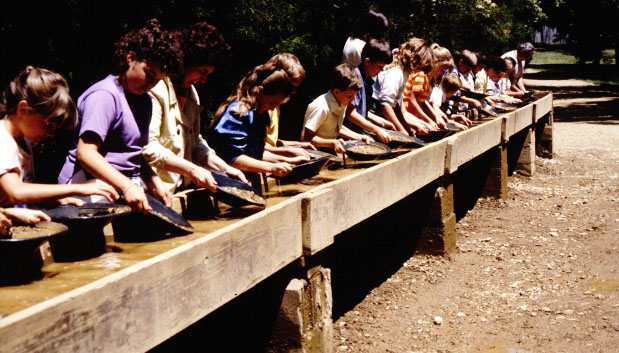State Mineral of North Carolina: Gold
 by Michelle Czaikowski and Amy Kemp
by Michelle Czaikowski and Amy Kemp
NC Government & Heritage Library, 2017
See also: North Carolina State Symbols and Official Adoptions main page, North Carolina Gold Rush, Gold in the Uwharries
On June 23, 2011, gold (Aurum) became North Carolina's official state mineral. (Session Law 2011-233)
Selection as State Mineral
The bill was initially introduced by Senate Majority Leader Harry Brown of Onslow County on behalf of a fourth-grade class at Clyde Erwin Magnet Elementary School. While a majority of senators were in favor of the adoption, four voted against the bill, citing the opposition of other mineral industries, such as quartz and feldspar, in their constituencies.
At least two other states have designated gold as their state mineral - Alaska and California.
About Gold
The discovery of gold by a twelve-year-old boy in 1799 in Cabarrus County started North Carolina's gold rush. The boy's name was Conrad Reed, and the location developed into the Reed Gold Mine.
Following the discovery, North Carolina remained the only gold producing state in the union until 1828, and the top producing state until the California gold rush of 1848.
While other minerals such as pyrite and yellow mica can be frequently mistaken for gold, the mineral has several defining characteristics. It is soft, measuring a 2.5-3 on the Mohs scale of hardness, but is also a heavy mineral, with a 19.3 specific gravity when pure. Unlike pyrite, gold extremely pliable and can be molded into sheets without breaking. It is also largely insoluble, only breaking down in a mixture of hydrochloric and nitric acid.
References and additional resources:
Ballew, Sigrid and Jeff Reid. 2000. "Gold in North Carolina." North Carolina Geological Survey Web site. Online at https://www.deq.nc.gov/about/divisions/energy-mineral-and-land-resources/nc-geological-survey. Accessed 12/2010.
Leslie, Laura. 2011. "Senate okays gold as state mineral." 5/23/2011. Online at: https://www.wral.com/news/state/nccapitol/blogpost/9635000/. Accessed July 2011.
Reed Gold Mine, NC Historic Sites, NC Department of Cultural Resources. Online at https://historicsites.nc.gov/all-sites/reed-gold-mine. Accessed 12/2010.
Resources on gold in North Carolina in libraries [via WorldCat]
11 July 2011 | Kemp, Amy; Underhill, Michelle Czaikowski